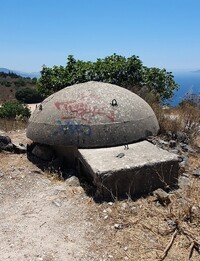Photo. Albania’s Bunkers: From Cold War Relics to Cultural Icons. No foreign army ever crossed Albania’s borders. But the bunkers stayed.
During my journey in Albania in July 2025, I explored the mushroom bunker mystery - strange, often mushroom-shaped constructions. What is this? And why was it built?
Scattered across Albania’s rugged hills and quiet fields, thousands of concrete domes rise from the earth like relics of another world. Built under the shadow of fear, the bunkers were a colossal undertaking - an all-consuming project that drained national resources and reshaped the economy. While schools, roads, and industry waited, concrete kept pouring. And the invasion they were meant to repel never came.
Through history there are several examples of “mad undertakings” by dictators. Some of these are Nicolae Ceaușescu – Palace of the Parliament (Romania), Built atop Bucharest’s Uranus Hill, demolishing entire neighborhoods to construct one of the world’s largest and most expensive administrative buildings. Kim Jong-il – Propaganda “Fake” Border Villages (North Korea). North Korea constructed seemingly prosperous model villages (e.g., Peace Village) along the DMZ to mislead observers into thinking citizens lived well—while they were empty or inhabited by soldiers. Adolf Hitler (Germany) – Nazi Megaprojects, Designed a new capital, “Welthauptstadt Germania,” with colossal buildings. Only a few structures were started before the war intervened.Grand restoration with a personal twist: Beginning in 1978, Saddam launched the “Archaeological Restoration of Babylon Project,” rebuilding temples, the Southern Palace, Ishtar Gate, an amphitheater, and even adding a palace atop an archaeological mound—once with a cable-car plan, later halted by the 2003 invasion, and once it was one in Albania too.
Enver Hoxha was the communist dictator of Albania who ruled the country with absolute power from 1944 until his death in 1985. He established one of the most repressive and isolationist regimes in the world during the Cold War.
Under Hoxha, Albania became one of the most closed-off countries on the planet. Foreign influence was seen as a threat and contact with the outside world was extremely limited.
One of his most notorious policies was the mass construction of concrete bunkers all over the country - around 170,000 of them. Hoxha was obsessed with the idea of invasion and wanted Albania to be always prepared for war. These were built under the regime of Enver Hoxha between the 1960s and 1980s as part of his extreme defence strategy. The density is staggering - roughly 5.7 bunkers per square kilometres, or about one bunker for every 11 people at the time of construction (source: Bunkers in Albania on Wikipedia).
The scale was absurd. Bunkers were placed in forests, on beaches, in backyards, in cemeteries - even in vineyards and along hiking trails. Many were barely usable, and most were never used at all. But that madness also left a legacy unlike any other in the world. What was once a symbol of fear has become an unlikely symbol of Albania’s uniqueness - something you can observe, touch, walk into, and reflect inside.
His regime was marked by strict censorship, political purges, secret police, and labour camps. Thousands were imprisoned or executed as “enemies of the state.” Despite the brutality, Hoxha maintained control through fear and propaganda, leaving behind a legacy that still shapes Albania's landscape and memory today.
Today, these ghostly sentinels of the Cold War stand not as symbols of war, but as markers of resilience, transformation, and even creativity. Some serve as humble animal shelters or storage sheds. Others have been reborn as cafes and art galleries. restaurants serving traditional food and wine, curiously unique settings for guesthouses, art and history museums, and even tattoo studios. People in Albania have suffered for a long time both in the communist era and afterwars – now they reach out their hands outside the borders and reconnect with rest of the world. It takes time, but the hope is there.
What began as a monument to isolation has become part of Albania’s evolving identity - a strange, stubborn beauty etched into the landscape. The bunkers, once born of paranoia, now echo with new purpose. Albania’s bunkers, once born of fear, now echo with creativity and reinvention.
Stein Morten Lund, July 2025
Additional information
Read more about bunkers in Albania on Wikipedia:
Hoxha's program of "bunkerization" (bunkerizimi) resulted in the construction of bunkers in every corner of the then-People's Socialist Republic of Albania, ranging from mountain passes to city streets.












